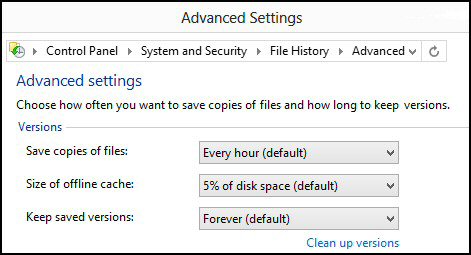Windows 8 File History
The benefit of this new Windows 8 feature is that it can recover deleted files. Once you setup this file caching mechanism, look in the Windows File Manager for History' – complete with a green down arrow.
Windows 8 File History Topics
♦
Windows 8 File History
File History is great for protecting your data, it has evolved from 'Previous Versions' in Windows 7. Once turned on, File History backs up files that are in your libraries automatically. Incidentally, this could be a killer reason to make better use of Windows 8 Libraries.
I was pleasantly surprised that it also caches, contacts, favourites, and even Microsoft SkyDrive. In the event that anything happens to your current files you can restore them easily. There is only one problem, Windows 8 does not activate File History by default.
Create a File History
To take advantage of this recovery feature of Windows 8 you need to:
a) Turn on File History
b) Create a shared drive on another machine so that you can store the back-ups.

That's it, job done! Setting up File History is intuitive and straightforward, if you get stuck 'Search' for File History. Naturally, you have to make sure both machines are turned on, also be aware that if the network connection is broken, it's not File History's fault.
Next Step – Restore Personal Files
Typical Microsoft! We have at least two ways of restoring files; either go to the Control Panel (see screenshot above), or else call for the Windows Explorer / File Manager see below. Another lovely feature is that you can find versions of your files that were created at a specific time.
Each method for recovering these protected folders is intuitive, for example, if you navigate to the Libraries \ Documents folder you should see the History icon burning brightly. Whereas, in unprotected folders the same icon is dimmed or greyed-out.
Guy Recommends: A Free Trial of the Network Performance Monitor (NPM) v11.5
v11.5
SolarWinds’ Orion performance monitor will help you discover what’s happening on your network. This utility will also guide you through troubleshooting; the dashboard will indicate whether the root cause is a broken link, faulty equipment or resource overload.
What I like best is the way NPM suggests solutions to network problems. Its also has the ability to monitor the health of individual VMware virtual machines. If you are interested in troubleshooting, and creating network maps, then I recommend that you try NPM now.
Download a free trial of Solarwinds’ Network Performance Monitor
Windows 8 File History – Advanced Features
It's worth clicking the Advanced Settings link just to see the default values, for example, Windows 8 saves copies every hour, and keeps an offline cache, which is especially good for laptops and tablets.
I think that hourly intervals are just right for saving files to the offline cache. In time you will need to clean up versions to reclaim disk space and ensure performance.
Another option in File History Advanced Features is the ability to exclude folders that are not important or not worth caching.
File History -v- Backup & Restore
Windows 8's special File History system automatically stores multiple copies of your files; furthermore, you can restore a file from its property tab relatively easily.
Backup and Restore saves a single copy and is a little more complex to restore. Backup is more likely to be used for large blocks of files and probably has a longer interval between copies.
Evolution of Windows 8 File History
- XP flirted with 'Enable Offline Files'.
- Vista employed the Synch Center.
- Windows 7 used Previous Versions to go back in time.
- Previously there was also Volume Shadow Copy.
- Windows 8 has the superior File History.
More Windows 8 How To Articles
- How to Configure the Windows 8 Lock Screen
- How to Control Metro IE 10
- How to Setup a Virtual Keyboard
- How to Join Windows 8 to a Domain
- How to Create an Image
Summary of Windows 8 File History
File History is great for recovering deleted or corrupted data files. It backs up files in key locations such as libraries automatically. Once you setup this file caching mechanism you will see 'History' with a bright green down arrow in the Windows file manager. Strangely, this new Windows 8 feature is not turned on by default.
If you like this page then please share it with your friends
Microsoft Windows 8 Topics
• Windows 8 Overview • Windows 8 Event Viewer • Win 8 Security Event Log • Log Event Manager
• Win 8 Task Manager • Close Windows 8 Apps • Windows 8 SkipRearm • Windows 8 File History
• Windows 8 App Store • Windows 8 Safely Remove Hardware • Windows 8 Shutdown Command



